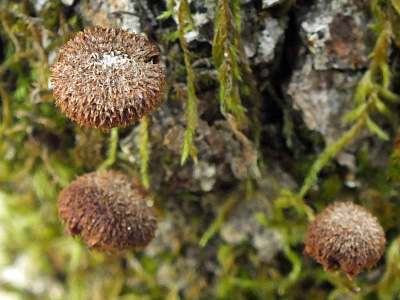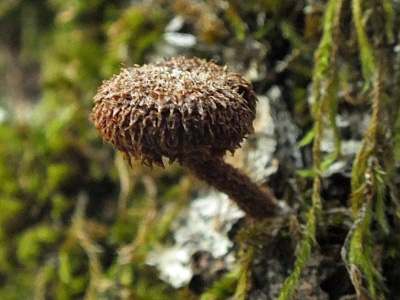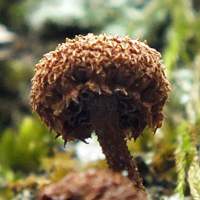Flammulaster muricatus (Fr.) Watling
Phylum: Basidiomycota - Class: Agaricomycetes - Order: Agaricales - Family: Inocybaceae
Distribution - Taxonomic History - Etymology - Identification - Culinary Notes - Reference Sources

This inconspicuous little mushroom is hard to find (and easy to miss even when you are looking in the right place). Not only is it rare and quite small, but with its shaggy orange-brown cap and stem it also blends in with the background of the fallen dead twigs and branches or standing decaying trunks of broad-leaf trees upon which it grows.

Distribution
Flammulaster muricatus is a rare and localised woodland species in southern Britain and Ireland. These swarthy little toadstools are found in many parts of central and southern mainland Europe. A very similar mushroom, Flammulaster erinaceellus (Peck) Watling, is found in North America.
Taxonomic history
In 1818 Swedish mycologist Elias Magnus Fries described this mushroom scientifically, giving it the name Agaricus muricatus. It was Scottish Roy Watling (b. 1938) who, in 1967, transferred this species to the genus Flammulaster, whereupon it acquired its currently-accepted scientific name Flammulaster muricatus.
Synonyms of Flammulaster muricatus include Agaricus muricatus Fr., Pholiota muricata (Fr.) P. Kumm., Dryophila muricata (Fr.) Quél., Naucoria muricata (Fr.) Kühner & Romagn., Phaeomarasmius muricatus (Fr.) Singer, Flocculina muricata (Fr.) P.D. Orton, and Flammulaster denticulatus P.D. Orton.
Etymology
Flammulaster, the genus name, comes from the Latin noun flammula, the diminutive of flamma, meaning a flame; while the specific epithet muricatus is also Latin and means muricate - in other words rough with short, hard points - a reference to the pointed scales on the caps.
Identification guide
 |
CapThe cap of Flammulaster muricatus has a diameter of 1 to 3cm. Initially hemispherical with an in-turned margin, it becomes broadly convex as the fruitbody matures. The orange-brown cap surface is covered with pointed upright scales, while longer scales hang down from the margin. GillsThe moderately spaced sinuate gills (with a slightly decurrent tooth) start off light ochre and become browner with age. StemCylindrical, often curved, 0.8 to 2.5mm in diameter and 1.3 to 3.5cm tall, the stem is orange-brown and fibrous and scaly below a persistent ring. |
SporesEllipsoidal, smooth 6-9 x 4-5µm. Spore printCreamy cinnamon-brown. |
|
Odour/taste |
Very faint odour of Pelagoniums. Taste generally indistinct but sometimes reported to be slightly bitter or metallic. |
Habitat & Ecological role |
On dead wood of deciduous trees, particularly Fagus (Beech), in small troops or occasionally tufted. |
Season |
June to November in Britain and Ireland. |
Similar species |
This scaly-capped little agaric could perhaps be mistaken for a small example of the Shaggy Scalycap Pholiota squarrosa, although the latter generally occurs in largish caespitose tufts. |
Culinary Notes
These tiny toadstools are close relatives of the fibrecaps, Inocybe species, some of which are known to be deadly poisonous. For this reason, at least, they should be avoided when gathering fungi for food.
Reference Sources
Fascinated by Fungi, 2nd Edition, Pat O'Reilly 2016, reprinted by Coch-y-bonddu Books in 2022.
BMS List of English Names for Fungi
Dictionary of the Fungi; Paul M. Kirk, Paul F. Cannon, David W. Minter and J. A. Stalpers; CABI, 2008
Taxonomic history and synonym information on these pages is drawn from many sources but in particular from the British Mycological Society's GB Checklist of Fungi.
Fascinated by Fungi. Back by popular demand, Pat O'Reilly's best-selling 450-page hardback book is available now. The latest second edition was republished with a sparkling new cover design in September 2022 by Coch-y-Bonddu Books. Full details and copies are available from the publisher's online bookshop...

